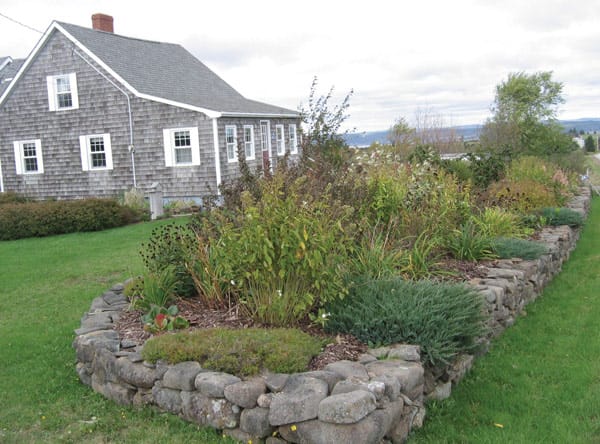Round or flat, large or small, local rocks can be turned into a strong, long-lived wall.
“Something there is that doesn’t love a wall,” wrote Robert Frost in his famous poem “Mending Wall.” I don’t know who could resist a stone wall as a garden feature or accent. When I see a well-built wall made of such native stone as granite, slate or sandstone, I want immediately to go home and build one in my own yard. Because I don’t like the look of mortar around rocks, except in a fireplace, I want a dry stone wall—one fitted together with just the weight of the stones to hold it in place. A couple of rows of stones around the perimeter of several beds has been about as much as I’ve managed, and these haven’t been properly fitted together or set into a proper foundation with good drainage. As a result, the stones are apt to tumble with little warning.
Neil Bennett, in Scotts Bay, NS, built a garden wall using local igenous rock, with “not a flat one in the pile,” he says. He worked at it when he could over the course of six years. The resulting wall is beautiful, with each individual stone fitted carefully against its neighbours. Neil and his family live on a property that has been in the family for generations; his grandfather picked thousands of pounds of rock from the soil when he farmed, so there was plenty available for Neil’s project. “Grandfather probably is turning in his grave,” he says, “seeing all those stones brought back after all his backbreaking work moving them over the years.”

Do it yourself walls
To do-it-yourself, determine where, how long and how high you want the wall, then order or collect the stone. For a wall two feet in height, dig a trench at least a foot deep and 18 inches wide, and put four to six inches of gravel in for drainage before laying the first row of stones. (If rock isn’t available on your own property, it can be purchased from a local quarry or supplier such as The Stone Depot or Scotia Slate.) Use large flat stones to act as a footing. If you’re using stone that can be cut, you’ll need a guillotine cutter and a circular saw or cutoff saw. Build upwards with layers of stone overlapping one row on top of the next, checking periodically that the wall is level. Finish the top row with capstones—flat rocks that fit together tightly across the width and length, giving the wall stability and a finished look.
Time and Expenses
 A good contractor can build a wall in a few days, depending on its length and height, and the complexity of the shape. Kristie Sheehy of Oakhill Landscaping and Nursery in Brooklyn, NS, has been building walls for nearly 20 years. “I’ve always loved the look of stone in walls, patios, walkways and water features,” she says. When she meets with a client, they discuss design possibilities and materials, she describes the construction process—Kristie and her husband Butch do all their work by hand when they are on a site, from digging the trenches and adding the gravel for drainage to cutting the stone to fit—and gives a price for the project, including all materials and labour.
A good contractor can build a wall in a few days, depending on its length and height, and the complexity of the shape. Kristie Sheehy of Oakhill Landscaping and Nursery in Brooklyn, NS, has been building walls for nearly 20 years. “I’ve always loved the look of stone in walls, patios, walkways and water features,” she says. When she meets with a client, they discuss design possibilities and materials, she describes the construction process—Kristie and her husband Butch do all their work by hand when they are on a site, from digging the trenches and adding the gravel for drainage to cutting the stone to fit—and gives a price for the project, including all materials and labour.
Contractor prices can range from $20 to $30 a square foot; a 50-foot-long, two-foot-high wall would cost between $2,000 and $3,000. As with so many landscaping projects, however, what is not seen is where most of the money goes. The base or footing of the wall, together with the drainage, takes the time and money; improperly built walls are, quite literally, money down the drain. Frost, improper drainage and other conditions will dismantle your hard work. Neil Bennett says if he were rebuilding his wall, he would dig deeper and do something more about drainage. The wall has moved because of frost heaving or significant wet periods.
As a gardener who knows a fair bit about plants but a lot less about landscaping, I think I’ll opt for the more costly but less difficult way, and hire a contractor to build a wall for me. It might cost a little more, but it will be here long after I’m gone. And there won’t be too much “Mending Wall,” either.
